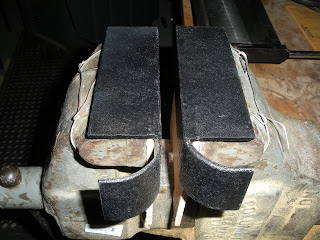Remember Christmas morning? Waiting to unwrap those toys under the tree. It was magical, just think of the fun you were going to have with that new bicycle, model airplane, or science kit. Now it's different. Instead of cool toys, we get pajamas, or a tie. Makes you long for the good ol' days.
So, since our manly needs aren't being met by the packages under the tree, we have reverted to making our toys (sometimes). It's actually quite rewarding. We take a piece of scrap, a saw, and a vice, and voila, a cool new toy!
Leo needs a pipe flatner/bender (I am sure there is a more official name). The drawing below shows an example of what he needs it for. The pipe shown has to be attached at each end with a bolt, at a specific angle. So it must be flattened, bent, and drilled. Okay, drilling can be done with one of the six drill presses we have, but we don't have a flattener/bender thingy.
This is one of those parts that is easy to draw, but hard to make (unless you have the right toy tool).
Leo saw this article written by Tony Bingelis, and her went to work.
The tool is simply a stout pair of angle iron, cut and bent to the shape shown, and inserted in a vice. This one is for symmetric flattening/bending.
This one is for asymmetric flattening/bending.
And her is a little better photo from a different angle.
I thought it would be fun to wrap it up in a brightly colored package and put Leo's name on it. Hey, how long until April 1st?



























